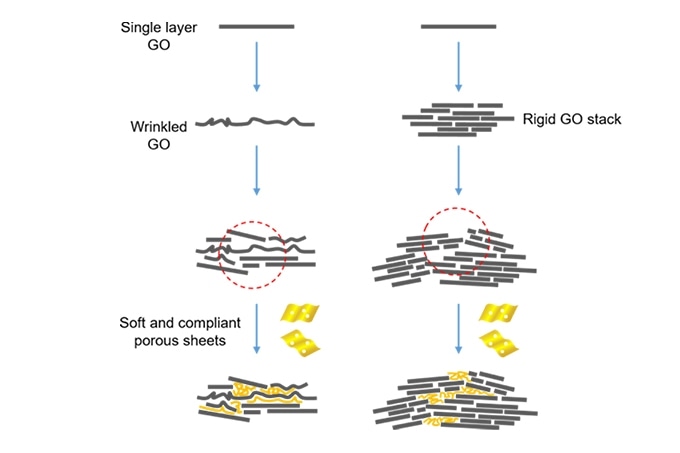Aug 19 2019
According to presumptions, developing a super-strong material from nano-scale building blocks requires the highest quality building blocks to start with. However, this is incorrect—at least when researchers work with “flakes” of graphene oxide (GO).
 Large single layers of GO wrinkle easily, leaving breakable gaps. Small, hard flakes don’t integrate well.
Large single layers of GO wrinkle easily, leaving breakable gaps. Small, hard flakes don’t integrate well.
An innovative study performed by Northwestern University scientists demonstrates that improved GO “paper” can be produced by combining strong, solid GO flakes with weak, porous GO flakes. The study outcomes will help in the production of higher quality GO materials, and it casts light on a common issue in materials engineering: how to develop a nano-scale material into a macroscopic material without losing its desired properties.
To put it in human terms, collaboration is very important. Excellent players can still make a bad team if they don’t work well together. Here, we add some seemingly weaker players and they strengthen the whole team.
Jiaxing Huang, Professor of Materials Science and Engineering, McCormick School of Engineering, Northwestern University
Huang also led the study.
The study was a four-way collaboration. Apart from Huang’s, three other teams took part, headed by Horacio Espinosa, professor of mechanical engineering at the McCormick School of Engineering; SonBinh Nguyen, professor of chemistry at Northwestern; and Tae Hee Han, a former postdoc researcher at the University who is now a professor of organic and nanoengineering at Hanyang University, South Korea.
The research was reported in Nature Communications on August 15th, 2019.
High-Tech Paper
GO is derived from graphite that can be employed to create the 2D, super material graphene. As GO is easier to produce, researchers investigate it as a model material. It usually comes as a dispersion of tiny flakes in water. From one end to the other, each flake is thinner than the width of a strand of human hair with a thickness of just 1 nm.
Upon pouring a solution of GO flakes onto a filter and on extracting the water, a thin “paper” is created, generally a few inches in diameter with a thickness less than or equal to 40 μm. The flakes are held together only by intermolecular forces and nothing else.
Strength from Weakness
Although researchers can create strong GO in single layers, layering the flakes into a paper form does not work too well. Huang and his colleagues discovered a solution while testing the effect of holes on the strength of GO flakes.
The scientists used a combination of ammonia and hydrogen peroxide to chemically “etch” holes in the GO flakes. Flakes that were left soaked for one to three hours were considerably weaker when compared to the un-etched flakes. After five hours of soaking, flakes became so weak that they could not be measured.
After that, the group found something exciting: Paper created from the weakened flakes was stronger than thought. At the single-layer level, one-hour-etched porous flakes, for instance, were 70% weaker when compared to solid flakes; however, the paper developed from those flakes was just 10% weaker when compared to those from solid flakes.
More astonishing things unraveled when the group combined solid flakes together with the porous flakes, Huang stated. Rather than weakening the paper created only from solid flakes, the addition of 25% or 10% of the weakest flakes strengthened it by around 70% and 95% percent, respectively.
Effective Connection
According to Huang, if GO sheets can be compared with aluminum foil, making a GO paper is similar to piling the foil up to form a thick aluminum slab. If started with large sheets of aluminum foil, there are more possibilities that many will wrinkle, hindering tight packing between sheets.
On the contrary, smaller sheets do not wrinkle as easily. They pack together well but form tight stacks that do not incorporate well with other tight stacks, forming holes within GO paper where it can easily break.
Weak flakes warp to fill in those voids, which improves the distribution of forces throughout the material. It’s a reminder that the strength of individual units is only part of the equation; effective connection and stress distribution is equally important.
Jiaxing Huang, Professor of Materials Science and Engineering, McCormick School of Engineering, Northwestern University
Huang stated that this finding will be directly applicable to other 2D materials, such as graphene, and will also result in the design of higher quality GO products. He wishes to test it out on GO fibers next.
The Office of Naval Research (ONRN000141612838) supported this research.